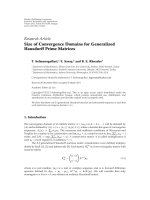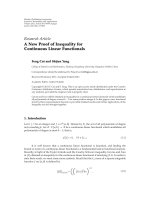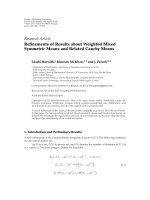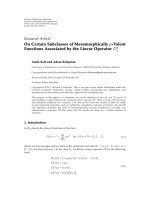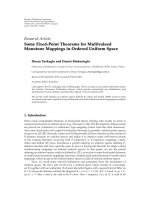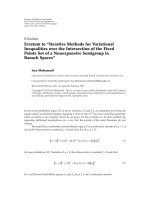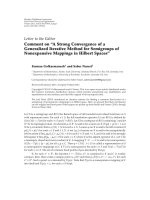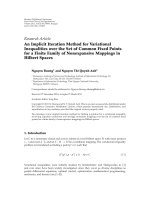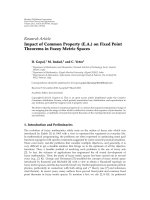Hindawi Publishing Corporation Fixed Point Theory and Applications Volume 2010, Article ID 296759, ppt
Bạn đang xem bản rút gọn của tài liệu. Xem và tải ngay bản đầy đủ của tài liệu tại đây (528.94 KB, 16 trang )
Hindawi Publishing Corporation
Fixed Point Theory and Applications
Volume 2010, Article ID 296759, 16 pages
doi:10.1155/2010/296759
Research Article
Strong Convergence Theorem for Equilibrium
Problems and Fixed Points of a Nonspreading
Mapping in Hilbert Spaces
Somyot Plubtieng and Sukanya Chornphrom
Department of Mathematics, Faculty of Science, Naresuan University, Phitsanulok 65000, Thailand
Correspondence should be addressed to Somyot Plubtieng,
Received 30 June 2010; Revised 10 October 2010; Accepted 13 December 2010
Academic Editor: Brailey Sims
Copyright q 2010 S. Plubtieng and S. Chornphrom. This is an open access article distributed under
the Creative Commons Attribution License, which permits unrestricted use, distribution, and
reproduction in any medium, provided the original work is properly cited.
We introduce an iterative method for finding a common element of the set of solutions of
equilibrium problems and the set of fixed points of a nonspreading mapping in a Hilbert space.
Then, we prove a strong convergence theorem which is connected with the work of S. Takahashi
and W. Takahashi 2007 and Iemoto and Takahashi 2009.
1. Introduction
Let H be a real Hilbert space with inner product ·, · and norm ·, respectively, and let C
be a closed convex subset of H.LetF : C × C →
be bifunction, where is the set of real
numbers. The equilibrium problem for F : C × C →
is to find x ∈ C such that
F
x, y
≥ 0 ∀y ∈ C. 1.1
The set of solution of 1.1 is denoted by EPF. Given a mapping A : C → H,let
Fx, yAx, y − x for all x, y ∈ C. Then, z ∈ EPF if and only if Az, y − z≥0forall
y ∈ C,thatis,z is a solution of the variational inequality. Numerous problems in physics,
optimization, and economics reduce to find a solution of 1.1; see, for example, 1–9 and
the references therein.
A mapping T of C into itself is said to be nonexpansive if Tx − Ty≤x − y for all
x, y ∈ C, and a mapping F
is said to be firmly nonexpansive if Fx − Fy
2
≤x − y, Fx − Fy
for all x, y ∈ C.LetE be a smooth, strictly convex and reflexive Banach space, and let J be the
2 Fixed Point Theory and Applications
duality mapping of E and C a nonempty closed convex subset of E. A mapping S : C → C is
said to be nonspreading if
φ
Sx, Sy
φ
Sy, Sx
≤ φ
Sx, y
φ
Sy, x
1.2
for all x, y ∈ C,whereφx, yx
2
−2x, Jyy
2
for all x, y ∈ E; see, for instance, Kohsaka
and Takahashi 10.InthecasewhenE is a Hilbert space, we know that φx, yx − y
2
for all x, y ∈ E. Then a nonspreading mapping S : C → C in a Hilbert space H is defined as
follows:
2
Sx − Sy
2
≤
Sx − y
2
x − Sy
2
1.3
for all x, y ∈ C.LetFQ be the set of fixed points of Q,andFQ nonempty; a mapping
Q : C → C is said to be quasi-nonexpansive if Qx − y≤x − y for all x ∈ C and y ∈ FQ.
Remark 1.1. In a Hilbert space, we know that every firmly n onexpansive mapping is
nonspreading and that if the set of fixed points of a nonspreading mapping is nonempty,
the nonspreading mapping is quasi-nonexpansive; see 10, 11.
In 1953, Mann 12 introduced the iteration as follows: a sequence {x
n
} defined by
x
n1
α
n
x
n
1 − α
n
Tx
n
, 1.4
where the initial guess element x
0
∈ C is arbitrary and {α
n
} is a real sequence in
0, 1. Mann iteration has been extensively investigated for nonexpansive mappings. In an
infinite-dimensional Hilbert space, Mann iteration can conclude only weak convergence see
12, 13. Fourteen years later, Halpern 14 introduced the following iterative scheme for
approximating a fixed point of T:
x
n1
α
n
x
1 − α
n
Tx
n
, 1.5
for all n ∈
,wherex
1
x ∈ C and {α
n
} is a sequence of 0, 1. Strong convergence of this
type iterative sequence has been widely studied: Wittmann 15 discussed such a sequence
in a Hilbert space.
On the other hand, Kohsaka and Takahashi 10 proved an existence theorem of fixed
point for nonspreading mappings in a Banach space. Recently, Lemoto and Takahashi 16
studied the approximation theorem of common fixed points f or a nonexpansive mapping T
of C into itself and a nonspreading mapping S of C into itself in a Hilbert space. In particular,
this r esult reduces to approximation fixed points of a nonspreading mapping S of C into itself
in a Hilbert space by using iterative scheme
x
n1
α
n
x
n
1 − α
n
Sx
n
. 1.6
Some methods have been proposed to solve the equilibrium problem and fixed point
problem of nonexpansive mapping: see, for instance, 1, 2, 6, 7, 17–20 and the references
Fixed Point Theory and Applications 3
therein. In 1997, Combettes and Hirstoaga 3 introduced an iterative scheme of finding
the best approximation to the initial data when EPF is nonempty a nd pro ved a strong
convergence theorem. Recently, S. Takahashi and W. Takahashi 8 introduced an iterative
scheme by the viscosity approximation method for finding a c ommon e lement of the set of
solution of equilibrium problems and the set of fixed points of a nonexpansive mapping
in a Hilbert space. Let S : C → H be a nonexpansive mapping. In 2008, Plubtieng a nd
Punpaeng 7 introduced a new iterative sequence for finding a common element of the set of
solution of equilibrium problems and the set of fixed points of a nonexpansive mapping in a
Hilbert space which is the optimality condition for the minimization problem. Very recently,
S. Takahashi and W. Takahashi 9 introduced an iterative method for finding a common
element of the set of solutions of a generalized equilibrium problem and the set of fixed points
of a nonexpansive mapping in a Hilbert space and then obtain that the sequence converges
strongly to a common element of two sets.
In this paper, motivated by S. Takahashi and W. Takahashi 8 and Lemoto and
Takahashi 16, we introduce an iterative sequence and prove a strong convergence theorem
for finding solution of equilibrium problems and the set of fixed points of a nonspreading
mapping in Hilbert spaces.
2. Preliminaries
Let H be a real Hilbert space. When {x
n
} is a sequence in H, x
n
ximplies that x
n
converges
weakly to x and x
n
→ x means the strong convergence. Let C be a nonempty closed convex
subset of H. For every point x ∈ H, there exists a unique nearest point in C;denotebyP
C
x,
such that
x − P
C
x
≤
x − y
∀y ∈ C. 2.1
P
C
is called the metric projection of H onto C. We know that P
C
is nonexpansive. Further, for
x ∈ H and z ∈ C,
z P
C
x ⇐⇒
x − z, z − y
≥ 0 ∀y ∈ C. 2.2
Moreover, P
C
x is characterized by the following properties: P
C
x ∈ C and
x − P
C
x, y − P
C
y
≤ 0,
x − y
2
≥
x − P
C
x
2
y − P
C
x
2
2.3
for all x ∈ H, y ∈ C. We also know that H satisfies Opial’s condition 21, that is, for any
sequence {x
n
}⊂H with x
n
x, the inequality
lim inf
n →∞
x
n
− x
< lim inf
n →∞
x
n
− y
2.4
holds for every y ∈ H with x
/
y;see21, 22 for more details.
4 Fixed Point Theory and Applications
The following lemmas will be useful for proving the convergence result of this paper.
Lemma 2.1 see 23. Let E, ·, · be an inner product space. Then for all x, y, z ∈ E and α, β, γ ∈
0, 1 with α β γ 1,onehas
αx βy γz
2
α
x
2
β
y
2
γ
z
2
− αβ
x − y
2
− αγ
x − z
2
− βγ
y − z
2
.
2.5
Lemma 2.2 see 10. Let H be a Hilbert space, C a nonempty closed convex subset of H.LetS be
a nonspreading mapping of C into itself. Then the following are equivalent.
1 There exists x ∈ C such that {S
n
x} is bounded;
2 FS is nonempty.
Lemma 2.3 see 10. Let H be a Hilbert space, C a nonempty closed convex subset of H.LetS be
a nonspreading mapping of C into itself. Then FS is closed and convex.
Lemma 2.4. Let H be a real Hilbert space. Then for all x, y ∈ H,
1 x y
2
≤x
2
2y, x y;
2 x y
2
≥x
2
2y, x.
Lemma 2.5 see 24. Let {a
n
}, {b
n
}⊂0, ∞,andlet{c
n
}⊂0, 1 be sequences of real numbers
such that
a
n1
≤ 1 − c
n
a
n
b
n
, for all n ∈ ,
∞
n1
c
n
∞ and
∞
n1
b
n
< ∞.
Then, lim
n →∞
a
n
0.
Lemma 2.6 see 16. Let H be a Hilbert space, C a closed convex subset of H,andS : C → C
a nonspreading mapping with FS
/
∅.ThenS is demiclosed, that is, x
n
uand x
n
− Sx
n
→ 0
imply u ∈ FS.
Lemma 2.7 see 16. Let H be a Hilbert space, C a nonempty closed convex subset of a real Hilbert
space H,andletS be a nonspreading mapping of C into itself, and let A I − S.Then
Ax − Ay
2
≤
x − y, Ax − Ay
1
2
Ax
2
Ay
2
.
2.6
Lemma 2.8 see 25. Assume {a
n
} is a sequence of nonnegative real numbers such that
a
n1
≤
1 − α
n
a
n
δ
n
,n≥ 0, 2.7
where {α
n
} is a sequence in 0, 1 and {δ
n
} is a sequence in such that
1
∞
n1
α
n
∞;
2 lim sup
n →∞
δ
n
/α
n
≤ 0 or
∞
n1
|δ
n
| < ∞.
Then lim
n →∞
a
n
0.
Fixed Point Theory and Applications 5
For solving the equilibrium problems for a bifunction F : C × C →
, let us assume
that F satisfies the following conditions:
A1 Fx, x0forallx ∈ C;
A2 F is monotone, that is, Fx, yFy, x ≤ 0forallx, y ∈ C;
A3 for each x, y, z ∈ C, lim
t↓0
Ftz 1 − tx, y ≤ Fx, y;
A4 for each x ∈ C, y → Fx, y is convex and lower semicontinuous.
The following lemma appears implicitly in 26.
Lemma 2.9 see 26. Let C be a nonempty closed convex subset of H,andletF be a bifunction of
C × C into
satisfying (A1)–(A4). Let r>0 and x ∈ H. Then, there exists z ∈ C such that
F
z, y
1
r
y − z, z − x
≥ 0 ∀y ∈ C.
2.8
The following lemma was also given in 4.
Lemma 2.10 see 4. Assume that F : C × C →
satisfies (A1)–(A4). For r>0 and x ∈ H,
define a mapping T
r
: H → C as follows:
T
r
x
z ∈ C : F
z, y
1
r
y − z, z − x
≥ 0, ∀y ∈ C
2.9
for all z ∈ H. Then, the following hold:
1 T
r
is single-valued;
2 T
r
is firmly nonexpansive, that is, for any x, y ∈ H, T
r
x − T
r
y
2
≤T
r
x − T
r
y, x − y;
3 FT
r
EPF;
4 EPF is closed and convex.
Lemma 2.11 see 27. Let Γ
n
be a sequence of real numbers that does not decrease at infinity, in
the sense that there exists a subsequence Γ
n
j
j≥0
of Γ
n
which satisfies Γ
n
j
< Γ
n
j
1
for all j ≥ 0.Also
consider the sequence of integers τn
n≥n
0
defined by
τ
n
max
{
k ≤ n | Γ
k
< Γ
k1
}
. 2.10
Then τn
n≥n
0
is a nondecreasing sequence verifying lim
n →∞
τn∞, and the following
properties are satisfied for all n ≥ n
0
:
Γ
τn
≤ Γ
τn1
, Γ
n
≤ Γ
τn1
. 2.11
3. Main Result
In this section, we prove a strong convergence theorem for finding a common element of the
set of fixed points of a nonspreading mapping and the set of solutions of the equilibrium
problems.
6 Fixed Point Theory and Applications
Theorem 3.1. Let C be a nonempty closed convex subset of a real Hilbert space H.LetF be a
bifunctions from C × C →
satisfying (A1)–(A4), and let S be a nonspreading mapping of C into
itself such that FS ∩EPF
/
∅.Letu ∈ C,andlet{x
n
} and {u
n
} be sequences generated by x
1
∈ C
and
F
u
n
,y
1
r
n
y − u
n
,u
n
− x
n
≥ 0, ∀y ∈ C,
x
n1
β
n
x
n
1 − β
n
S
α
n
u
1 − α
n
u
n
,
3.1
for all n ∈
,where{α
n
}, {β
n
}∈0, 1 and {r
n
}∈0, ∞ satisfy
lim
n →∞
α
n
0,
∞
n1
α
n
∞, 0 <a≤ β
n
≤ b<1 ,
∞
n1
|α
n
− α
n−1
| < ∞,
∞
n1
|β
n
− β
n−1
| < ∞,
lim inf
n →∞
r
n
> 0,and
∞
n1
|r
n1
− r
n
| < ∞.
Then {x
n
} converges strongly to z ∈ FS ∩ EPF,wherez P
FS∩EPF
u.
Proof. Let p ∈ FS ∩ EPF.Fromu
n
T
r
n
x
n
,wehave
u
n
− p
T
r
n
x
n
− T
r
n
p
≤
x
n
− p
3.2
for all n ∈
.Puty
n
α
n
u 1 − α
n
u
n
. We divide the proof into several steps.
Step 1. We claim that the sequences {x
n
}, {u
n
}, {y
n
},and{Sy
n
} are bounded. Fir st, we note
that
Sy
n
− p
≤
y
n
− p
α
n
u
1 − α
n
u
n
− p
≤ α
n
u − p
1 − α
n
u
n
− p
≤ α
n
u − p
1 − α
n
x
n
− p
,
3.3
and so
x
n1
− p
β
n
x
n
1 − β
n
Sy
n
− p
≤ β
n
x
n
− p
1 − β
n
Sy
n
− p
≤ β
n
x
n
− p
1 − β
n
y
n
− p
β
n
x
n
− p
1 − β
n
α
n
u
1 − α
n
u
n
− p
≤ β
n
x
n
− p
1 − β
n
α
n
u − p
1 − α
n
u
n
− p
≤ β
n
x
n
− p
1 − β
n
α
n
u − p
1 − α
n
x
n
− p
1 − α
n
1 − β
n
x
n
− p
α
n
1 − β
n
u − p
.
3.4
Fixed Point Theory and Applications 7
Putting M max{x
n
− p, u − p},wenotethatx
n
− p≤M for a ll n ∈ . In fact, it is
obvious that x
1
− p≤M. Assume that x
k
− p≤M for all k ∈ . Thus, we have
x
k1
− p
≤
1 − α
k
1 − β
k
x
k
− p
α
k
1 − β
k
u − p
≤
1 − α
k
1 − β
k
M α
k
1 − β
k
M
M.
3.5
By induction, we obtain that x
n
− p≤M for all n ∈ .So,{x
n
} is bound. Hence, {u
n
}, {y
n
},
and {Sy
n
} are also bounded.
Step 2. Put t
n
β
n
y
n
1 − β
n
Sy
n
. We claim that x
n1
− t
n
→0asn →∞.Wenotethat
x
n1
− x
n
β
n
x
n
1 − β
n
Sy
n
−
β
n−1
x
n−1
1 − β
n−1
Sy
n−1
β
n
x
n
− β
n
x
n−1
β
n
x
n−1
− β
n−1
x
n−1
1 − β
n
Sy
n
−
1 − β
n
Sy
n−1
1 − β
n
Sy
n−1
−
1 − β
n−1
Sy
n−1
≤ β
n
x
n
− x
n−1
β
n
− β
n−1
x
n−1
1 − β
n
Sy
n
− Sy
n−1
1 − β
n
−
1 − β
n−1
Sy
n−1
≤ β
n
x
n
− x
n−1
β
n
− β
n−1
x
n−1
1 − β
n
y
n
− y
n−1
β
n−1
− β
n
Sy
n−1
β
n
x
n
− x
n−1
β
n
− β
n−1
x
n−1
1 − β
n
×
α
n
u
1 − α
n
u
n
− α
n−1
u −
1 − α
n−1
u
n−1
β
n
− β
n−1
Sy
n−1
≤ β
n
x
n
− x
n−1
β
n
− β
n−1
x
n−1
1 − β
n
×
α
n
u − α
n−1
u
1 − α
n
u
n
−
1 − α
n−1
u
n−1
β
n
− β
n−1
Sy
n−1
β
n
x
n
− x
n−1
β
n
− β
n−1
x
n−1
1 − β
n
|
α
n
− α
n−1
|
u
1 − β
n
1 − α
n
u
n
−
1 − α
n
u
n−1
1 − α
n
u
n−1
−
1 − α
n−1
u
n−1
β
n
− β
n−1
Sy
n−1
≤ β
n
x
n
− x
n−1
β
n
− β
n−1
x
n−1
1 − β
n
|
α
n
− α
n−1
|
u
1 − β
n
1 − α
n
u
n
− u
n−1
1 − β
n
|
1 − α
n
−
1 − α
n−1
|
u
n−1
β
n
− β
n−1
Sy
n−1
β
n
x
n
− x
n−1
β
n
− β
n−1
x
n−1
1 − β
n
|
α
n
− α
n−1
|
u
1 − β
n
1 − α
n
u
n
− u
n−1
1 − β
n
|
α
n
− α
n−1
|
u
n−1
β
n
− β
n−1
Sy
n−1
β
n
x
n
− x
n−1
β
n
− β
n−1
K
1
1 − β
n
|
α
n
− α
n−1
|
K
1
1 − β
n
1 − α
n
u
n
− u
n−1
1 − β
n
|
α
n
− α
n−1
|
K
1
β
n
− β
n−1
K
1
,
3.6
8 Fixed Point Theory and Applications
where K
1
sup{x
n
Sy
n
u u
n−1
: n ∈ }. On the other hand, from u
n
T
r
n
x
n
and
u
n1
T
r
n1
x
n1
,wehave
F
u
n
,y
1
r
n
y − u
n
,u
n
− x
n
≥ 0,
3.7
F
u
n1
,y
1
r
n1
y − u
n1
,u
n1
− x
n1
≥ 0
3.8
for all y ∈ C. Putting y u
n1
in 3.7 and y u
n
in 3.8,wehave
F
u
n
,u
n1
1
r
n
u
n1
− u
n
,u
n
− x
n
≥ 0,
F
u
n1
,u
n
1
r
n1
u
n
− u
n1
,u
n1
− x
n1
≥ 0.
3.9
So, from A2,wenotethat
u
n1
− u
n
,
u
n
− x
n
r
n
−
u
n1
− x
n1
r
n1
≥ 0, 3.10
and hence
u
n1
− u
n
,u
n
− u
n1
u
n1
− x
n
−
r
n
r
n1
u
n1
− x
n1
≥ 0. 3.11
Without loss of generality, let us assume that there exists a real number d such that r
n
>d>0
for all n ∈
. Thus, we have
u
n1
− u
n
2
≤
u
n1
− u
n
,x
n1
− x
n
1 −
r
n
r
n1
u
n1
− x
n1
≤
u
n1
− u
n
x
n1
− x
n
1 −
r
n
r
n1
u
n1
− x
n1
,
3.12
and hence
u
n1
− u
n
≤
x
n1
− x
n
1
r
n1
|
r
n1
− r
n
|
u
n1
− x
n1
≤
x
n1
− x
n
1
d
|
r
n1
− r
n
|
L,
3.13
Fixed Point Theory and Applications 9
where L sup{u
n
− x
n
: n ∈ }. So, from 3.6,wenotethat
x
n1
− x
n
≤ β
n
x
n
− x
n−1
2
β
n
− β
n−1
K
1
2
1 − β
n
|
α
n
− α
n−1
|
K
1
1 − β
n
1 − α
n
x
n
− x
n−1
1
d
|
r
n
− r
n−1
|
L
β
n
1 − β
n
1 − α
n
x
n
− x
n−1
2
β
n
− β
n−1
K
1
2
1 − β
n
|
α
n
− α
n−1
|
K
1
1 − β
n
1 − α
n
1
d
|
r
n
− r
n−1
|
L
1 −
1 − β
n
α
n
x
n
− x
n−1
2
β
n
− β
n−1
K
1
2
1 − β
n
|
α
n
− α
n−1
|
K
1
1 − β
n
1 − α
n
L
d
|
r
n
− r
n−1
|
.
3.14
By Lemma 2.5,wehave
lim
n →∞
x
n1
− x
n
0
3.15
for p ∈ FS ∪ EPF.Wenotefromu
n
T
r
n
x
n
that
u
n
− p
2
T
r
n
x
n
− T
r
n
p
2
≤
T
r
n
x
n
− T
r
n
p, x
n
− p
u
n
− p, x
n
− p
1
2
u
n
− p
2
x
n
− p
2
−
x
n
− u
n
2
,
3.16
and hence
u
n
− p
2
≤
x
n
− p
2
−
x
n
− u
n
2
.
3.17
Therefore, from the convexity of ·
2
,wehave
x
n1
− p
2
β
n
x
n
1 − β
n
Sy
n
− p
2
≤ β
n
x
n
− p
2
1 − β
n
Sy
n
− p
2
≤ β
n
x
n
− p
2
1 − β
n
y
n
− p
2
β
n
x
n
− p
2
1 − β
n
α
n
u
1 − α
n
u
n
− p
2
≤ β
n
x
n
− p
2
α
n
1 − β
n
u − p
2
1 − β
n
1 − α
n
u
n
− p
2
≤ β
n
x
n
− p
2
α
n
1 − β
n
u − p
2
1 − β
n
1 − α
n
x
n
− p
2
−
x
n
− u
n
2
1 −
1 − β
n
α
n
x
n
− p
2
α
n
1 − β
n
u − p
2
1 − β
n
1 − α
n
x
n
− u
n
2
,
3.18
10 Fixed Point Theory and Applications
and hence
1 − β
n
1 − α
n
x
n
− u
n
2
≤ α
n
1 − β
n
u − p
2
− α
n
1 − β
n
x
n
− p
2
x
n
− p
2
−
x
n1
− p
2
α
n
1 − β
n
u − p
2
− α
n
1 − β
n
x
n
− p
2
x
n
− p
−
x
n1
− p
x
n
− p
x
n1
− p
≤ α
n
1 − β
n
u − p
2
− α
n
1 − β
n
x
n
− p
2
x
n
− x
n1
x
n
− p
x
n1
− p
.
3.19
So, we have x
n
− u
n
→0. Indeed, since y
n
α
n
u 1 − α
n
u
n
, it follows that
lim
n →∞
x
n
− y
n
lim
n →∞
x
n
−
α
n
u
1 − α
n
u
n
lim
n →∞
α
n
1 − α
n
x
n
−
α
n
u
1 − α
n
u
n
≤ lim
n →∞
α
n
x
n
− u
1 − α
n
x
n
− u
n
lim
n →∞
α
n
x
n
− u
lim
n →∞
1 − α
n
x
n
− u
n
0.
3.20
Then, we note that
x
n1
− t
n
β
n
x
n
1 − β
n
Sy
n
−
β
n
y
n
1 − β
n
Sy
n
β
n
x
n
− y
n
1 − β
n
Sy
n
− Sy
n
β
n
x
n
− y
n
.
3.21
Since, 0 <a≤ β
n
≤ b<1andx
n
− y
n
→0, it follows that
lim
n →∞
x
n1
− t
n
0.
3.22
Step 3. Put A I − S.FromAp 0, it follows by Lemma 2.7 that
t
n
− p
2
β
n
y
n
1 − β
n
Sy
n
− p
2
y
n
− p
−
1 − β
n
y
n
− Sy
n
2
y
n
− p
−
1 − β
n
Ay
n
2
y
n
− p
2
− 2
1 − β
n
y
n
− p, Ay
n
− Ap
1 − β
n
2
Ay
n
2
Fixed Point Theory and Applications 11
≤
y
n
− p
2
− 2
1 − β
n
Ay
n
− Ap
2
−
1
2
Ay
n
2
Ap
2
1 − β
n
2
Ay
n
2
α
n
u − p
1 − α
n
u
n
− p
2
− 2
1 − β
n
Ay
n
2
1 − β
n
Ay
n
2
1 − β
n
2
Ay
n
2
≤ α
n
u − p
2
1 − α
n
u
n
− p
2
− β
n
1 − β
n
Ay
n
2
≤ α
n
u − p
2
1 − α
n
x
n
− p
2
− β
n
1 − β
n
Ay
n
2
≤ α
n
u − p
2
x
n
− p
2
− β
n
1 − β
n
Ay
n
2
.
3.23
Since 0 <a≤ β
n
≤ b<1, we have β
n
1 − β
n
≥ a1 − b : K
2
. Therefore, by 3.23,weobtain
K
2
y
n
− Sy
n
2
K
2
Ay
n
2
≤ α
n
u − p
2
x
n
− p
2
−
t
n
− p
2
≤ α
n
M
2
x
n
− p
2
−
t
n
− p
2
α
n
M
2
x
n
− p
2
−
t
n
− x
n1
x
n1
− p
2
α
n
M
2
x
n
− p
2
−
t
n
− x
n1
2
− 2
t
n
− x
n1
,x
n1
− p
−
x
n1
− p
2
≤ α
n
M
2
x
n
− p
2
−
x
n1
− p
2
− 2
t
n
− x
n1
,x
n1
− p
.
3.24
Step 4. Putting z P
FS∩EPF
u, we claim that the sequence {x
n
} converges strongly to z
P
FS∩EPF
u. Indeed, we discuss two possible cases.
Case 1. Assume that there exists n
0
such that the sequence {x
n
− p} is a nonincreasing
sequence for all n ≥ n
0
.Thenwehavex
n1
− p≤x
n
− p for n ≥ n
0
, and hence
lim
n →∞
x
n
− p exists. Therefore
lim
n →∞
x
n
− p
lim
n →∞
x
n1
− p
.
3.25
By 3.22, 3.24,and3.25,weget
y
n
− Sy
n
−→ 0. 3.26
Let {y
n
i
} be a subsequence of {y
n
} such that
lim sup
n →∞
u − z, y
n
− z
lim
n →∞
u − z, y
n
i
− z
.
3.27
12 Fixed Point Theory and Applications
Since {y
n
} is bounded, there exists a subsequence {y
n
i
} of {y
n
} which converges weakly to
w. Without loss of generality, we can assume that y
n
i
w.SinceC is closed and convex,
we note that C is weakly closed. So, we have w ∈ C.SinceSy
n
− y
n
→0, it follows by
Lemma 2.6 that w ∈ FS.From3.27 and the property of metric projection, we have
lim sup
n →∞
u − z, y
n
− z
lim
n →∞
u − z, y
n
i
− z
u − z, w − z
≤ 0.
3.28
Finally, we prove that x
n
→ z.Infact,sincey
n
− z α
n
u − z1 − α
n
u
n
− z, it follows that
x
n1
− z
2
β
n
x
n
1 − β
n
Sy
n
− z
2
≤ β
n
x
n
− z
2
1 − β
n
Sy
n
− z
2
≤ β
n
x
n
− z
2
1 − β
n
y
n
− z
2
≤ β
n
x
n
− z
2
1 − β
n
1 − α
n
2
x
n
− z
2
2α
n
u − z, y
n
− z
≤ β
n
x
n
− z
2
1 − β
n
1 − α
n
x
n
− z
2
2α
n
1 − β
n
u − z, y
n
− z
1 − α
n
1 − β
n
x
n
− z
2
2α
n
1 − β
n
u − z, y
n
− z
.
3.29
By 3.28 and
∞
n1
α
n
∞, we immediately d educe by Lemma 2.8 that x
n
→ z.
Case 2. Assume that for all n ∈
,thereexitsm ≥ n such that x
m
− p < x
m1
− p.Put
a
m
: x
m
− p for all m ∈ . Thus, it follows that there exists a subsequence a
n
k
k≥1
of
a
n
n≥1
such that a
n
k
<a
n
k1
for all k ∈ .Letϕ :
1
→ be a mapping defined by
ϕ
n
max
{
k ≤ n : a
k
≤ a
k1
}
, 3.30
where
1
{n ∈ : n ≥ n
1
}.ByLemma 2.11,wenotethatϕn is a nondecreasing sequence
such that ϕn →∞as n →∞and that the following properties are satisfied by all numbers
n ≥ n
1
:
a
ϕn
≤ a
ϕn1
,a
n
≤ a
ϕn1
. 3.31
From 3.24,wehave
K
2
y
ϕn
− Sy
ϕn
2
≤ α
ϕn
M
2
x
ϕn
− p
2
−
x
ϕn1
− p
2
− 2
t
ϕn
− x
ϕn1
,x
ϕn1
− p
≤ α
ϕn
M
2
− 2
t
ϕn
− x
ϕn1
,x
ϕn1
− p
.
3.32
Fixed Point Theory and Applications 13
This implies that
y
ϕn
− Sy
ϕn
−→ 0. 3.33
Take a subsequence {y
ϕn
i
} of {y
ϕn
} such that
lim sup
n →∞
u − z, y
ϕn
− z
lim
n →∞
u − z, y
ϕn
i
− z
.
3.34
From the boundedness of {y
ϕn
i
}, we can assume that y
ϕn
i
v.SinceC is closed and
convex, it follows that C is weakly closed. So, we have v ∈ C.SinceSy
ϕn
− y
ϕn
→0, it
follows by Lemma 2.6 that v ∈ FS.From3.34 and the property of metric projection, we
have
lim sup
n →∞
u − z, y
ϕn
− z
lim
n →∞
u − z, y
ϕn
i
− z
u − z, v − z
≤ 0.
3.35
Bythesameargumentas3.29 in Case 1, we conclude immediately that, for all n ≥ 1,
0 ≤
x
ϕn1
− z
2
−
x
ϕn
− z
2
≤ β
ϕn
x
ϕn
− z
2
1 − β
ϕn
Sy
ϕn
− z
2
−
x
ϕn
− z
2
≤ β
ϕn
x
ϕn
− z
2
1 − β
ϕn
y
ϕn
− z
2
−
x
ϕn
− z
2
≤ β
ϕn
x
ϕn
− z
2
1 − β
ϕn
×
1 − α
ϕn
2
u
ϕn
− z
2
2α
ϕn
u − z, y
ϕn
− z
−
x
ϕn
− z
2
≤ β
ϕn
x
ϕn
− z
2
1 − β
ϕn
1 − α
ϕn
u
ϕn
− z
2
2α
ϕn
1 − β
ϕn
u − z, y
ϕn
− z
−
x
ϕn
− z
2
≤ β
ϕn
x
ϕn
− z
2
1 − β
ϕn
1 − α
ϕn
x
ϕn
− z
2
2α
ϕn
1 − β
ϕn
u − z, y
ϕn
− z
−
x
ϕn
− z
2
α
ϕn
1 − β
ϕn
2
u − z, y
ϕn
− z
−
x
ϕn
− z
2
≤ 2
u − z, y
ϕn
− z
−
x
ϕn
− z
2
,
3.36
which implies that
x
ϕn
− z
2
≤ 2
u − z, y
ϕn
− z
.
3.37
14 Fixed Point Theory and Applications
By 3.35,wehave
lim
n →∞
x
ϕn
− z
0,
3.38
and hence
lim
n →∞
x
ϕn1
− z
lim
n →∞
x
ϕn
− z
0.
3.39
Since x
n
− z a
n
≤ a
ϕn
x
ϕn
− z for all n ≥ n
1
,wehave
lim
n →∞
x
n
− z
0.
3.40
This completes the proof.
As direct consequences of Theorem 3.1, we obtain corollaries.
Corollary 3.2. Let C be a nonempty closed convex subset of a real Hilbert space H.LetF be a
bifunctions from C × C →
satisfying (A1)–(A4), and let S be a firmly nonexpansive mapping
of C into itself such that FS ∩ EPF
/
∅.Letu ∈ C,andlet{x
n
} and {u
n
} be sequences generated
by x
1
∈ C and
F
u
n
,y
1
r
n
y − u
n
,u
n
− x
n
≥ 0, ∀y ∈ C,
x
n1
β
n
x
n
1 − β
n
S
α
n
u
1 − α
n
u
n
,
3.41
for all n ∈
,where{α
n
}, {β
n
}∈0, 1 and {r
n
}∈0, ∞ satisfy
lim
n →∞
α
n
0,
∞
n1
α
n
∞, 0 <a≤ β
n
≤ b<1 ,
∞
n1
|α
n
− α
n−1
| < ∞,
∞
n1
|β
n
− β
n−1
| < ∞,
lim inf
n →∞
r
n
> 0,and
∞
n1
|r
n1
− r
n
| < ∞.
Then {x
n
} converges strongly to z ∈ FS ∩ EPF,wherez P
FS∩EPF
u.
Acknowledgments
The authors would like to thank the referees for the insightful comments and suggestions.
Moreover, the authors gratefully acknowledge the Thailand Research Fund Master Research
Grants TRF-MAG, MRG-WII515S029 for funding this paper.
References
1 S S. Chang, H. W. Joseph Lee, and C. K. Chan, “A new method for solving equilibrium problem
fixed point problem and variational inequality problem with application to optimization,” Nonlinear
Analysis Theory: Methods & Applications, vol. 70, no. 9, pp. 3307–3319, 2009.
Fixed Point Theory and Applications 15
2 V. Colao, G. Marino, and H K. Xu, “An iterative method for finding common solutions of equilibrium
andfixedpointproblems,”Journal of Mathematical Analysis and Applications, vol. 344, no. 1, pp. 340–
352, 2008.
3 P. L. Combettes and S. A. Hirstoaga, “Equilibrium programming using proximal-like algorithms,”
Mathematical Programming, vol. 78, no. 1, pp. 29–41, 1997.
4 P. L. Combettes and S. A. Hirstoaga, “Equilibrium programming in Hilbert spaces,” Journal of
Nonlinear and Convex Analysis, vol. 63, pp. 123–145, 1994.
5 J W. Peng, Y. Wang, D. S. Shyu, and J C. Yao, “Common solutions of an iterative scheme for
variational inclusions, equilibrium problems, and fixed point problems,” Journal of Inequalities and
Applications, vol. 2008, Article ID 720371, 15 pages, 2008.
6 S. Plubtieng and R. Punpaeng, “A new iterative method for equilibrium problems and fixed
point problems of nonexpansive mappings and monotone mappings,” Applied Mathematics and
Computation, vol. 197, no. 2, pp. 548–558, 2008.
7 S. Plubtieng and R. Punpaeng, “A general iterative method for equilibrium problems and fixed point
problems in Hilbert spaces,” Journal of Mathematical Analysis and Applications, vol. 336, no. 1, pp. 455–
469, 2007.
8 S. Takahashi and W. Takahashi, “Viscosity approximation methods for equilibrium problems and
fixed point problems in Hilbert spaces,” Journal of Mathematical Analysis and Applications, vol. 331, no.
1, pp. 506–515, 2007.
9 S. Takahashi and W. Takahashi, “Strong convergence theorem for a generalized equilibrium problem
and a nonexpansive mapping in a Hilbert space,” Nonlinear Analysis: Theory, Methods & Applications,
vol. 69, no. 3, pp. 1025–1033, 2008.
10 F. Kohsaka and W. Takahashi, “Fixed point theorems for a class of nonlinear mappings related to
maximal monotone operators in Banach spaces,” Archiv der Mathematik, v ol. 91, no. 2, pp. 166–177,
2008.
11 S. Plubtieng and K. Sombut, “Weak convergence theorems for a system of mixed equilibrium
problems and nonspreading mappings in a Hilbert space,” Journal of Inequalities and Applications,vol.
2010, Article ID 246237, 12 pages, 2010.
12 W. R. Mann, “Mean value methods in iteration,” Proceedings of the American Mathematical Society,vol.
4, pp. 506–510, 1953.
13 S. Reich, “Weak convergence theorems for nonexpansive mappings in Banach spaces,” Journal of
Mathematical Analysis and Applications, vol. 67, no. 2, pp. 274–276, 1979.
14 B. Halpern, “Fixed points of nonexpanding maps,” Bulletin of the American Mathematical Society,vol.
73, pp. 957–961, 1967.
15 R. Wittmann, “Approximation of fixed points of nonexpansive mappings,” Archiv der Mathematik,vol.
58, no. 5, pp. 486–491, 1992.
16 S. Iemoto and W. Takahashi, “Approximating common fixed points of nonexpansive mappings and
nonspreading mappings in a Hilbert space,” Nonlinear Analysis: Theory, Methods & Applications,vol.
71, no. 12, pp. e2082–e2089, 2009.
17 S. Plubtieng and W. Sriprad, “A viscosity approximation method f or finding common solutions of
variational inclusions, equilibrium problems, and fixed point problems in Hilbert spaces,” Fixed Point
Theory and Applications, vol. 2009, Article ID 567147, 20 pages, 2009.
18 S. Plubtieng and W. Sriprad, “Hybrid methods for equilibrium problems and fixed points problems
of a countable family of relatively nonexpansive mappings in Banach spaces,” Fixed Point Theory and
Applications, vol. 2010, Article ID 962628, 17 pages, 2010.
19 S. Plubtieng and T. Thammathiwat, “A viscosity approximation method for equilibrium problems,
fixed point problems of nonexpansive mappings and a general system of variational inequalities,”
Journal of Global Optimization, vol. 46, no. 3, pp. 447–464, 2010.
20 S. Plubtieng and T. Thammathiwat, “A viscosity approximation method for finding a common
solution of fixed points and equilibrium problems in Hilbert spaces,” Journal of Global Optimization.In
press.
21 Z. Opial, “Weak convergence of the sequence of successive approximations for nonexpansive
mappings,” Bulletin of the American Mathematical Society, vol. 73, pp. 591–597, 1967.
22 W. Takahashi, Nonlinear Functional Analysis, Yokohama Publishers, Yokohama, Japan, 2000.
23 M. O. Osilike and D. I. Igbokwe, “Weak and strong convergence theorems for fixed points of
pseudocontractions and solutions of monotone type operator equations,” Computers & Mathematics
with Applications, vol. 40, no. 4-5, pp. 559–567, 2000.
16 Fixed Point Theory and Applications
24 H. K. Xu, “An iterative approach to quadratic optimization,” Journal of Optimization Theory and
Applications, vol. 116, no. 3, pp. 659–678, 2003.
25 H K. Xu, “Viscosity approximation methods for nonexpansive mappings,” Journal of Mathematical
Analysis and Applications, vol. 298, no. 1, pp. 279–291, 2004.
26 E. Blum and W. Oettli, “From optimization and variationnal inequalities to equilibrium problems,”
Mathematics Students, vol. 6, pp. 117–136, 2005.
27 P E . Ma ing
´
e, “Strong convergence of projected subgradient methods for nonsmooth and nonstrictly
convex minimization,” Set-Valued Analysis, vol. 16, no. 7-8, pp. 899–912, 2008.
